Relational database management systems (RDBMS) like PostgreSQL and MySQL are critical for storing, organizing, and accessing data for applications and analytics. PostgreSQL and MySQL are popular open-source databases with long histories and rich feature sets.
Database
A database is a collection of information accessible to computers. Databases are used to store information such as customer records, product catalogs, and financial transactions.
Read MoreHowever, PostgreSQL and MySQL differ in their technical architectures and design philosophy. If you’re stuck between picking one database for your application, this guide is for you.
We dig into the technical, practical, and strategic differences between PostgreSQL and MySQL. Let’s get started.
A Brief Background On PostgreSQL And MySQL
Before diving into the comparisons, let’s briefly introduce PostgreSQL and MySQL.
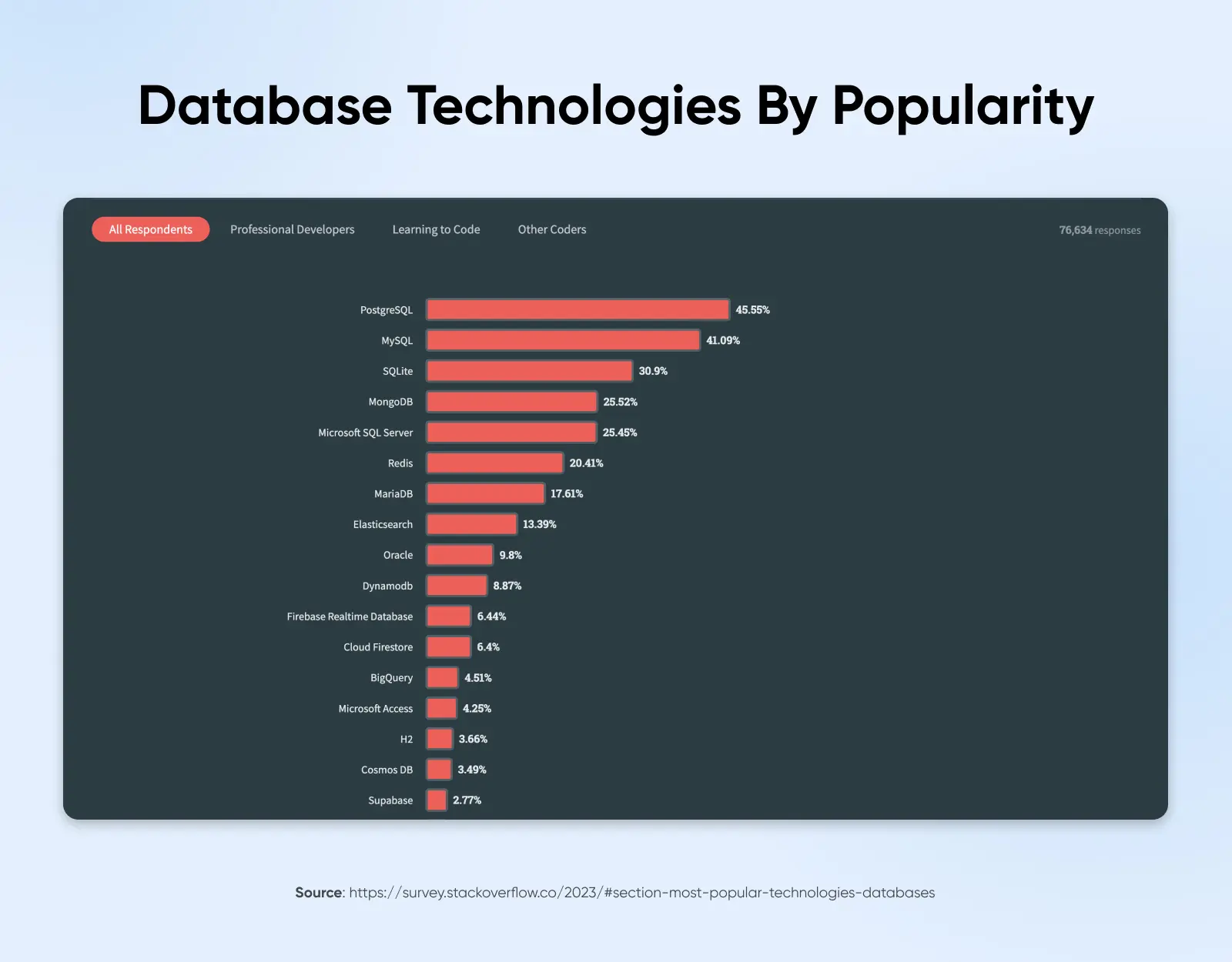
PostgreSQL is an enterprise-level open-source relational database. Used by over 45% of the 76,000 respondents in the recent StackOverflow developer survey, PostgreSQL overtook MySQL to become the most popular database in 2024.
PostgreSQL emphasizes standards compliance, extensibility, and proven architectures. The PostgreSQL project began in 1986 at the University of California, Berkeley, and has developed features focused on reliability, robustness, data integrity, and correctness.
Postgres employs a five-level system:
- Instance (also called cluster)
- Database
- Schema
- Table
- Column
Here is an example of creating a simple users table in PostgreSQL and inserting some rows:
CREATE TABLE users (
user_id SERIAL PRIMARY KEY,
name VARCHAR(50),
email VARCHAR(100)
);
INSERT INTO users (name, email) VALUES
('John Doe', 'john@email.com'),
('Jane Smith', 'jane@email.com');
MySQL is an open-source RDBMS started by the Swedish company MySQL AB in 1995, which Oracle later acquired. It has traditionally prioritized speed, simplicity, and ease of use for developing web and embedded applications. MySQL’s design emphasizes quick read and write performance.
MySQL employs a four-level system:
- Instance
- Database
- Table
- Column
Here is how you can create the user’s table in MySQL:
CREATE TABLE users (
user_id INT AUTO_INCREMENT PRIMARY KEY,
name VARCHAR(50),
email VARCHAR(100)
);
INSERT INTO users (name, email) VALUES
('John Doe', 'john@email.com'),
('Jane Smith', 'jane@email.com');
As you may notice, both queries are similar except for the INT AUTO_INCREMENT changing to SERIAL.
Fun fact: PostgreSQL supports NASA’s “allballs” keyword (meaning “all zeros”) as another way to express the time at midnight (local and UTC):
postgres=# SELECT 'allballs'::TIME;
time
----------
00:00:00
(1 row)
So, how do these two open-source database titans stack up? Let’s explore further.
PostgreSQL Vs. MySQL: Performance Comparison
Both PostgreSQL and MySQL are capable of excellent performance, but there isn’t a clear winner between them.
If you test read/write speed, you’ll notice no consistency in how PostgreSQL and MySQL perform. This is because database performance depends heavily on your specific workload type, hardware configuration, database schema and indexes, and especially database configuration tuning. Essentially, the performance depends greatly on your application’s workload and configurations.
There are five general categories of workloads:
- CRUD: Simple READ, WRITE, UPDATE, and DELETE operations.
- OLTP: Transactional, complex operations of data processing.
- OLAP: Analytical batch processes.
- HTAP: Hybrid transactional and analytics processing.
- Time-Series: Time-series data with very simple, but high-frequency access patterns.
When working with either of these workflows, you’ll observe that:
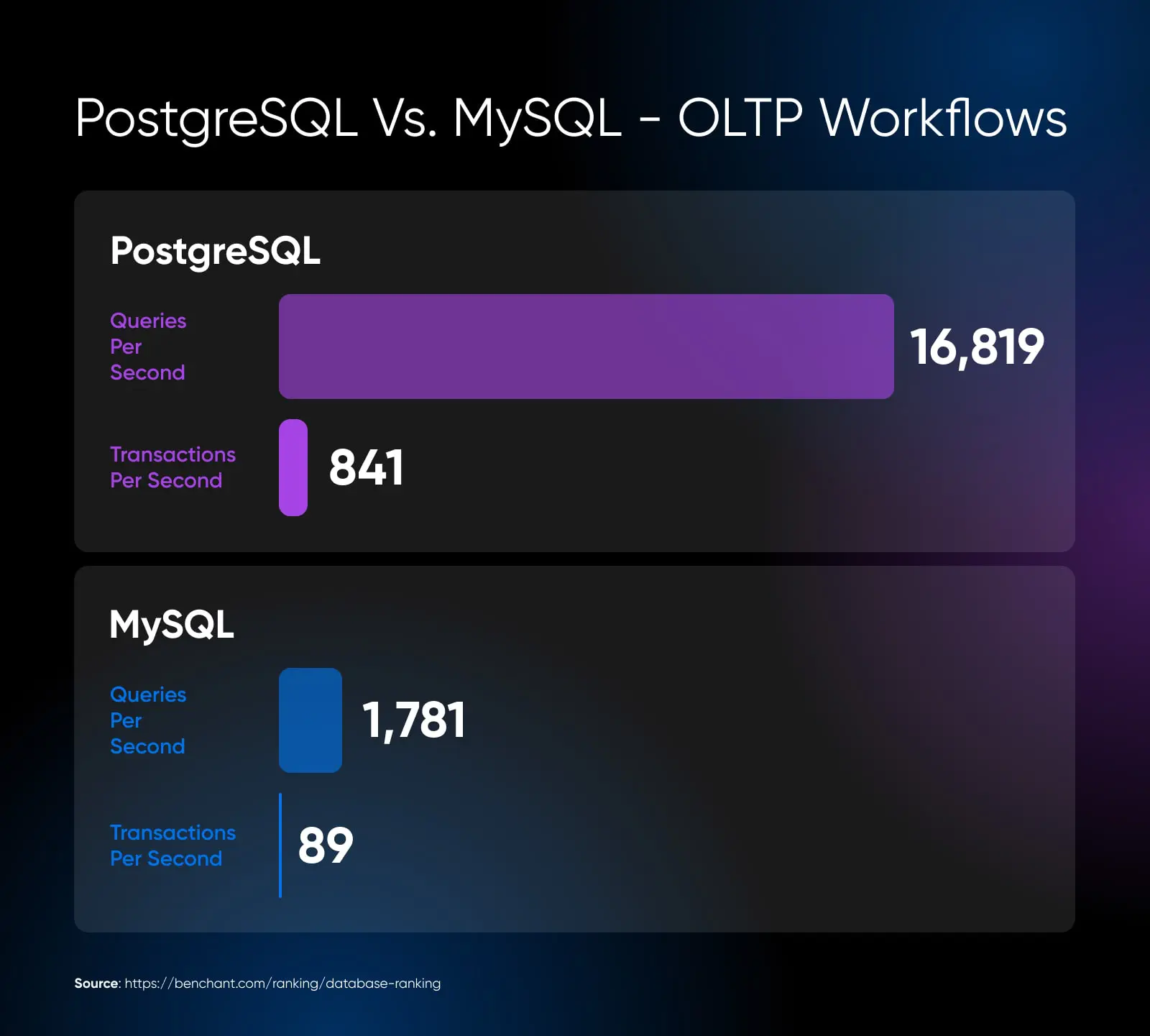
PostgreSQL is known to handle heavy OLAP and OLTP workloads quite efficiently. These workloads involve extremely complex, long-running queries that analyze massive data sets—for instance, business intelligence queries or geospatial analysis.
“Postgres lets me view a “before the query is executed” plan estimate, as well as an “after execution” plan. The latter gives me detailed info of how the query actually ran, how long each specific step in the query took, indexes used, and how much memory each step consumed.”
MySQL is generally good for simpler CRUD and OLTP workloads involving faster reads and writes, like web or mobile applications.
Both databases can shine depending on server configuration and your schema for hybrid workloads with a mix of OLTP and OLAP querying needs.
Query
In databases, queries are requests for specific sets of information. Queries can also be open-ended questions for data that matches your set parameters.
Read MoreWhen it comes to raw power on optimized hardware, PostgreSQL generally scales better to use the high memory, faster processors, and more cores available on the hardware.
Read Performance
MySQL generally has faster read times for applications than write operations. However, after the recent updates to PostgreSQL, it has caught up to the read speed differences.

This read performance advantage stems from differences in how the two systems are architected — MySQL’s storage engines are highly optimized for fast single-threaded sequential access.
Of course, with customized tuning and schemas, PostgreSQL can also deliver excellent read performance for many applications. But out of the box, MySQL often has an edge.
Write Performance
When it comes to writing performance, including bulk loads and complex queries that modify data, the general consensus is that PostgreSQL works better.
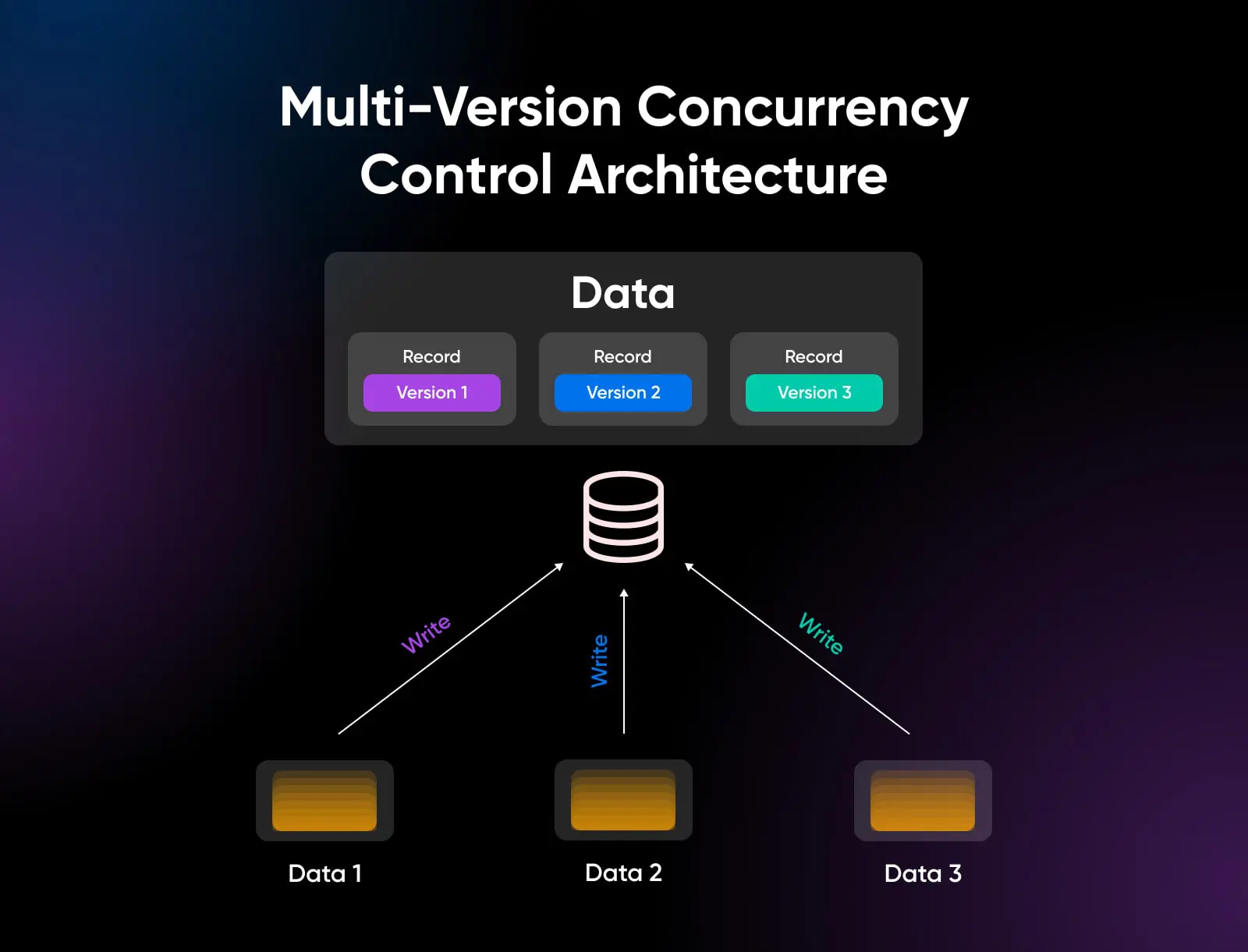
Its multi-version concurrency control (MVCC) architecture gives PostgreSQL a major advantage in allowing multiple sessions to update data with minimal locking concurrently.
If your application needs to support many concurrent users modifying data, PostgreSQL’s write throughput can surpass what MySQL can achieve.
Complex Query Performance
For advanced analytical queries that perform large table scans, sorts, or analytics functions, PostgreSQL also outshines MySQL in many cases — and it does so with a significant margin.

PostgreSQL’s mature SQL query optimizer and support for advanced SQL syntax give it an advantage in quickly executing intricate analytic queries. MySQL has significantly improved recently but relies more on manual query tuning.
So, for business intelligence or data warehousing needs where complex multi-table SQL performance matters, PostgreSQL often excels.
Configuration Impacts Performance
Of course, databases can be configured and optimized to suit different workloads. So, for any use case, the “best” system still depends significantly on the underlying server hardware, operating system, storage subsystem, database configuration, and schema design.
BenchANT does a great job of showing how different servers can impact a database’s performance.
Along with that, the hardware configuration also makes a significant impact on your database performance. For example, if you use a VPS with NVMe storage, the underlying storage is much faster than a regular hard drive, so your database operations will be extremely fast.
However, there isn’t a universally fastest system – your mileage will vary based on your environment and tuning.
“Connection management is the best argument for MySQL. Nevertheless, there is actually no real reason not to use PostgreSQL in any relational use case. This is especially true if you consider the developments in the last 3 years. Postgresql is years ahead of any competitor when it comes to relational databases and even beyond that. The striving community, amazingly organized source code, and almost godlike documentation are only three of the winning arguments.”
— Reddit user, themusician985
When To Consider MySQL
MySQL often outperforms PostgreSQL, using fewer system resources for simple schemas and applications dominated by fast key-value read access. Web and mobile applications with more significant needs for scalability, availability, and distributed reads can benefit from MySQL’s strengths.
When To Consider PostgreSQL
PostgreSQL’s architectural advantages make it worth considering for workloads requiring complex write-access patterns, business analytics querying, or flexibility in data types. If you have database administrators available for configuration and query optimization, PostgreSQL provides a competent foundation.
PostgreSQL Vs. MySQL: Feature Comparison
Both databases are full-featured but show considerable differences in supported data types, functions, and overall feature sets.
Data Type Support
| Feature | PostgreSQL | MySQL |
| Data Types | Robust built-in support for JSON, XML, arrays, geospatial, network, etc | It relies more on JSON extensions |
| Functional Languages | SQL, C, Python, JavaScript | Primarily SQL |
| GIS Support | Excellent via PostGIS spatial extension | Limited, often requires add-ons |
PostgreSQL supports a broader set of native data types, enabling more flexibility in your database schemas:
- Geometric types for GIS systems
- Network address types like IPV4/IPV6
- Native JSON and JSONB – optimized binary JSON
- XML documents
- Array types
- Multi-data-type columns
“Postgres has nice array handling. So you can store array types such as an array of ints or an array of varchars in your table. There are also various array functions and operators to read the arrays, manipulate them, and so on.”
— Reddit user, mwdb
MySQL has more basic data typing – mostly numeric, date/time, and string fields, but can achieve similar flexibility via JSON columns or spatial extensions.
Functional Languages
PostgreSQL allows functions and stored procedures to be written in various languages — SQL, C, Python, JavaScript, and more — for greater flexibility.
In contrast, MySQL stored routines must be coded in SQL, while you can still write the application logic in various general-purpose languages.
So, if you need to embed application logic or complex calculations directly into database procedures, PostgreSQL provides much more flexibility.
GIS Support
For spatial datasets used in mapping/geographic applications, PostgreSQL offers excellent built-in functionality via its PostGIS extension. Location queries, points-within-polygons, and proximity calculations all work out of the box.
MySQL’s spatial support is more limited unless you adopt a third-party spatial engine like MySQL Spatial or Integration MySOL. For GIS systems, PostgreSQL with PostGIS is generally a more straightforward, more capable solution.
Replication
Both databases offer replication, allowing database changes to be synchronized across instance. Out of the box, PostgreSQL replication is based on WAL (Write Ahead Log) files, which allows websites to be scaled out to incorporate as many database servers as your heart desires.
So, PostgreSQL makes it easier to scale out read replicas finely synchronized with specific data portions that change. For MySQL, third-party tools may be needed.
Architecture And Scalability
PostgreSQL and MySQL differ substantially in their overall architectures, which impacts their scalability and performance profiles.
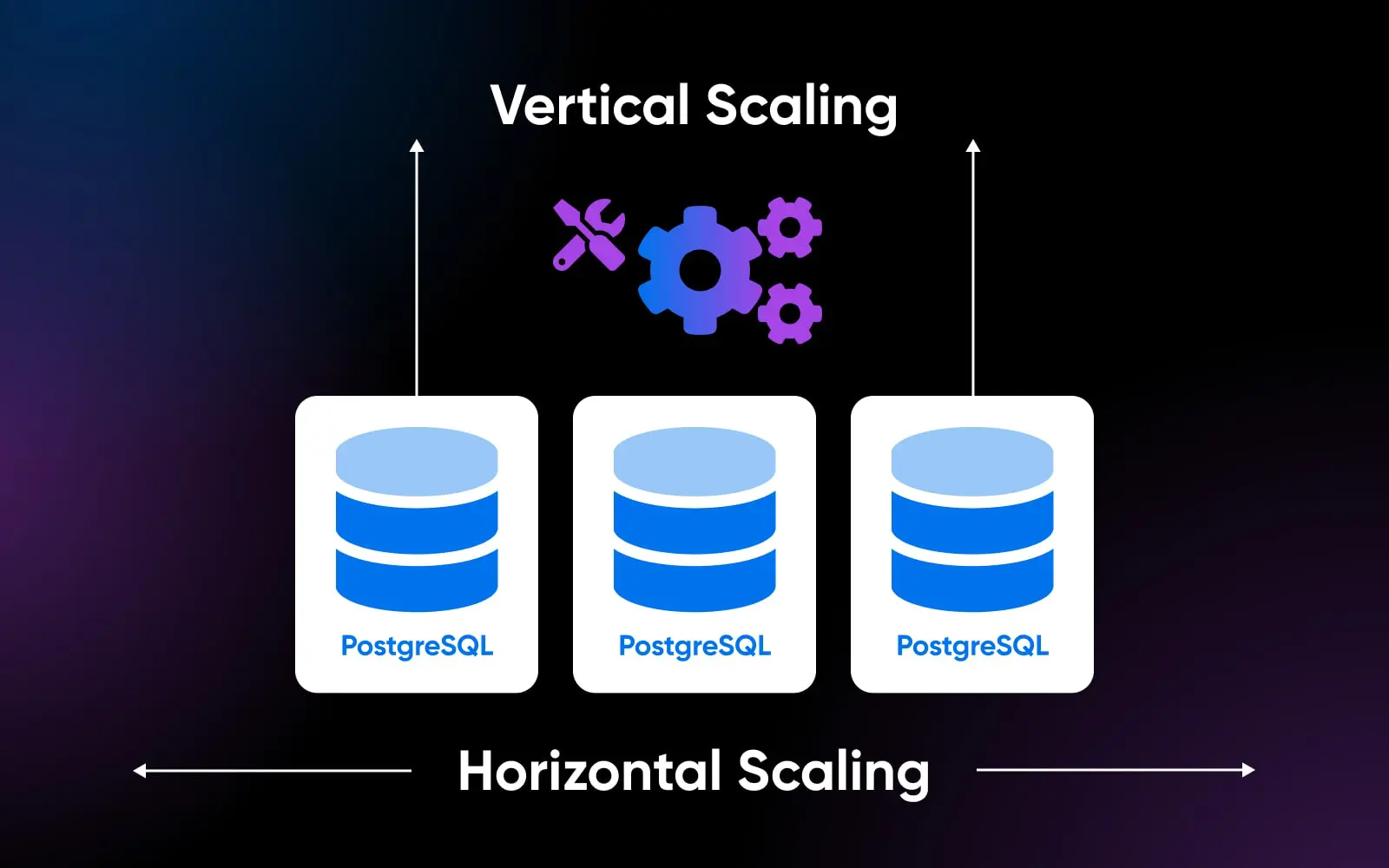
PostgreSQL’s Object-Relational Model
A key PostgreSQL architectural trait is its adherence to the object-relational model, which means data can take on characteristics similar to objects in object-oriented programming. For example:
- Tables can inherit properties from other tables.
- Data types can have specialized behaviors.
- Functions are features of data types.
This Object-Relational structure allows modeling complex real-world data closer to application objects and entities. However, it comes at a cost — More elaborate internal systems are needed to track richer data relationships.
The object-relational extensions thus give excellent flexibility, resulting in performance overhead relative to a strictly relational system.
MySQL’s Pure Relational Model
In contrast, MySQL follows a purely relational model centered around simple data table schema and relations through foreign keys. This simpler model translates to good performance for website-driven transactional workloads.
Advanced MySQL usage with extensive JOIN operations or localized business logic is handled better via application code rather than database customizations. MySQL opts for simplicity over flexibility in its core architecture.
Unlike PostgreSQL, MySQL is a purely relational database without object-oriented features. Each database consists of individual tables with no inheritance or custom types. JSON has recently provided some document database flexibility.
However, by avoiding object features, MySQL achieves higher out-of-the-box performance in many workloads, but it lacks PostgreSQL’s deeper modeling capabilities.
So, MySQL is faster for simple data, while PostgreSQL adapts better to complexity. Choose based on your data access and scaling needs.
Write Scaling With Multiversion Concurrency Control (MVCC)
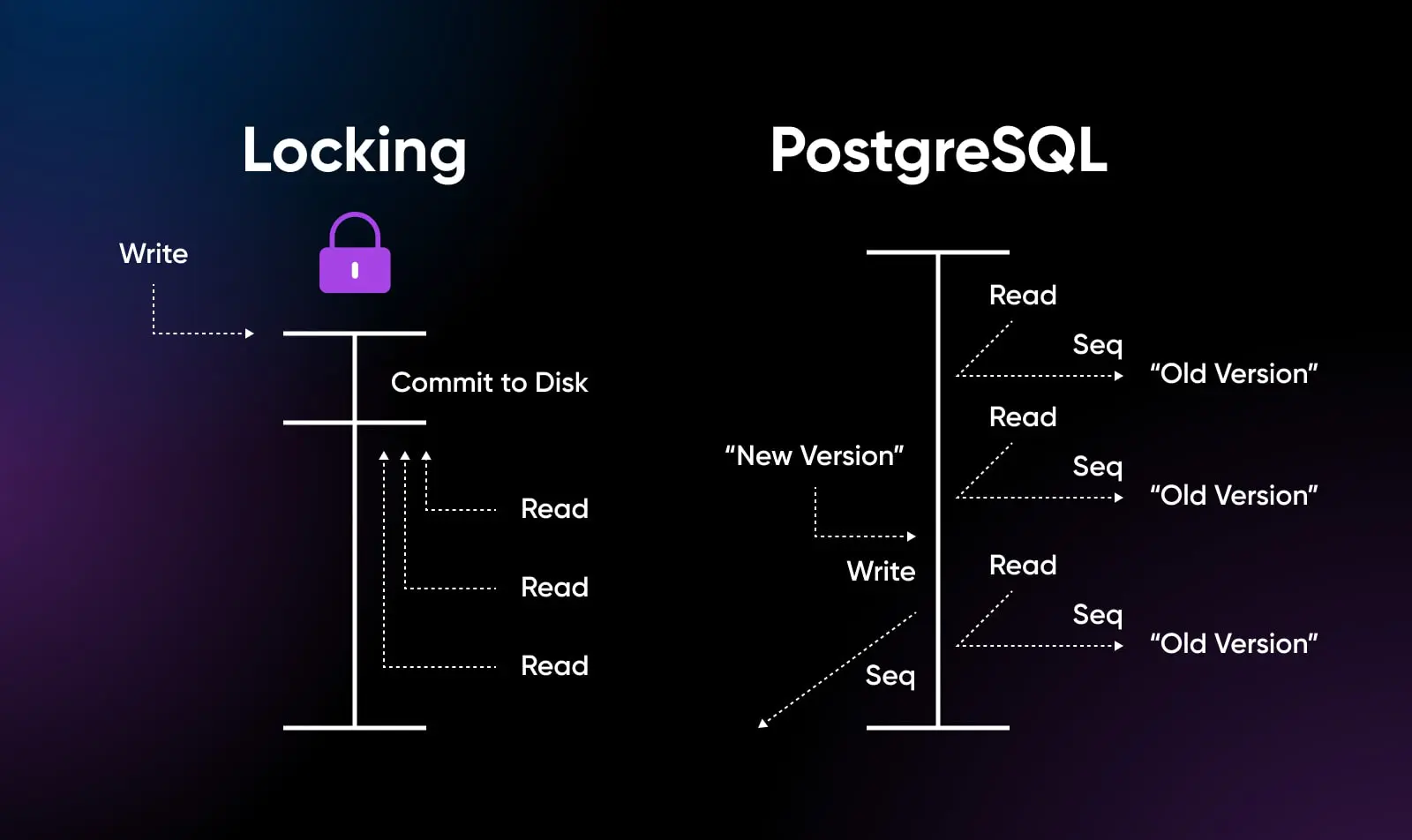
An area where PostgreSQL particularly excels is horizontal write scaling, allowing many concurrent sessions to modify data across distributed servers using the MVCC model.
This MVCC model means excellent concurrency even for mixed read-write workloads, allowing PostgreSQL databases to scale very large throughput via replication. Writes proceed in parallel, then sync after.
MySQL InnoDB achieves similar concurrency using row-level locking rather than MVCC. but PostgreSQL’s architecture has proven more scalable under high write loads in testing.
Essentially, PostgreSQL ultimately supports greater write scaling, albeit with more server overhead. MySQL is lighter-weight for read scaling.
PostgreSQL Vs. MySQL: Reliability And Data Protection
PostgreSQL and MySQL provide robust security protections and reliability mechanisms – though PostgreSQL emphasizes durability while MySQL focuses on high availability.
Access Control And Encryption
PostgreSQL and MySQL also provide user account controls, privileges administration, and network encryption capabilities for security. Critical items like SSL connections, password policies, and role-based row-level security apply similarly.
However, there are a few differences around encryption:
- Native data-at-rest encryption: PostgreSQL 13 added pgcrypto module for file-system transparent tablespace encryption. MySQL lacks native encryption but supports plugins.
- Lightweight row access policies: PostgreSQL has RLS and MASK for roles to manage row visibility down to data domains through policies. MySQL can use views to get a similar result, but it’s not as robust.
While both RDBMS systems protect sensitive data via SSL/TLS encryption for client connections, PostgreSQL offers slightly more encryption cipher algorithms, activity monitoring, and built-in access control options than MySQL.
PostgreSQL Reliability Through WAL
PostgreSQL uses write-ahead logging (WAL), where data changes are recorded in the log before the actual data modifications occur.
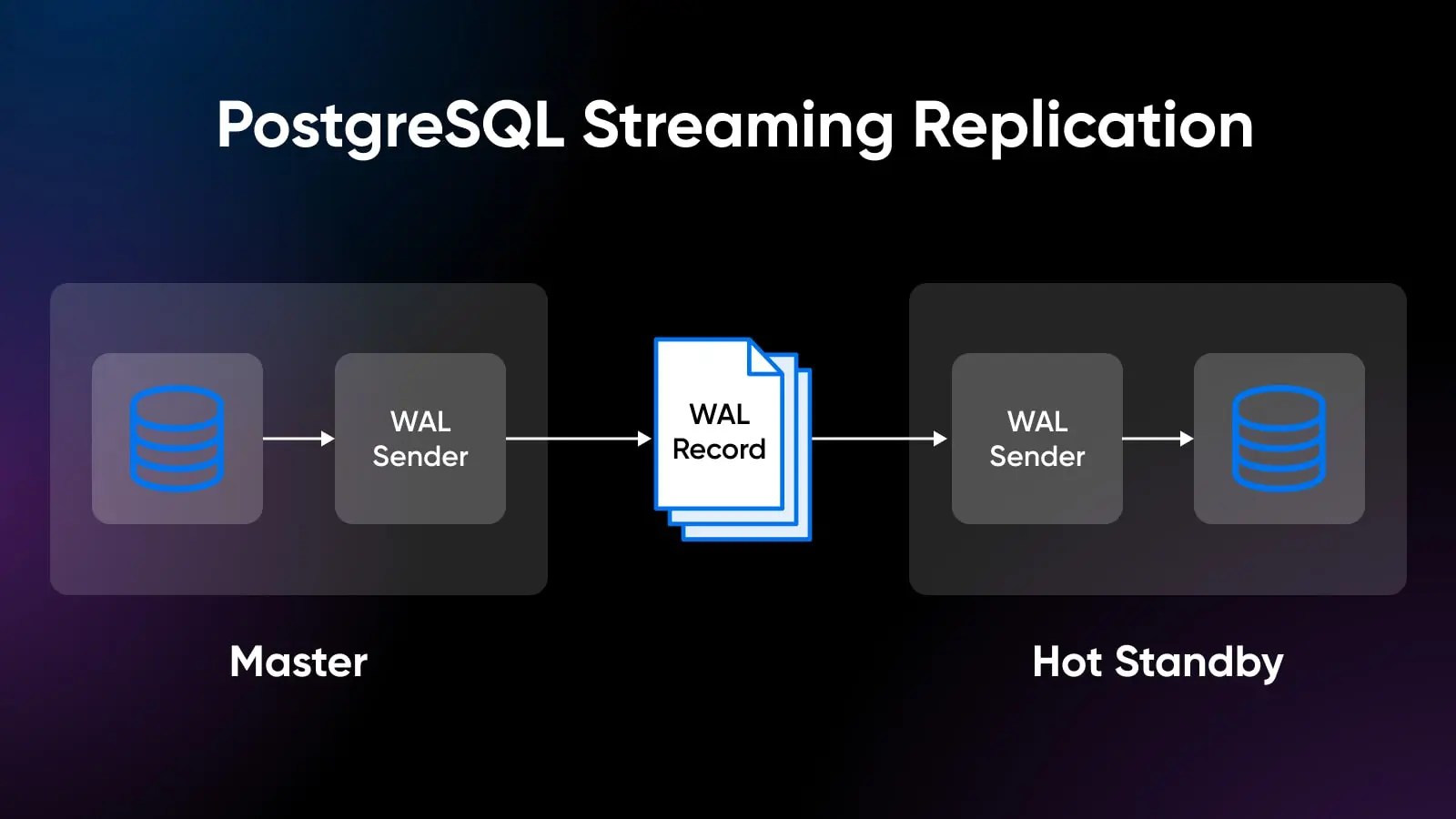
This protects against data loss, even in crashes or power failures, preventing database corruption.
The WAL logs in PostgreSQL maintain a consistent chain of changes queued across transactions that can quickly replay and recover data.
This mechanism powers features like streaming replication, parallel queries, and point-in-time recovery (PITR) to previous states in time without needing full backups.
Overall, WAL helps maintain data durability guarantees and performance boosts for crash recovery and replication.
MySQL High Availability
For minimizing downtime, MySQL offers robust high-availability clustering that auto-fails over in case any single server crashes – with minimal interruption. The automatic promotion of replicas and quick re-synchronization make outages a rare-case scenario.
While MySQL 5.7 did not include built-in high availability, MySQL 8 introduced InnoDB cluster for automated failover between nodes.
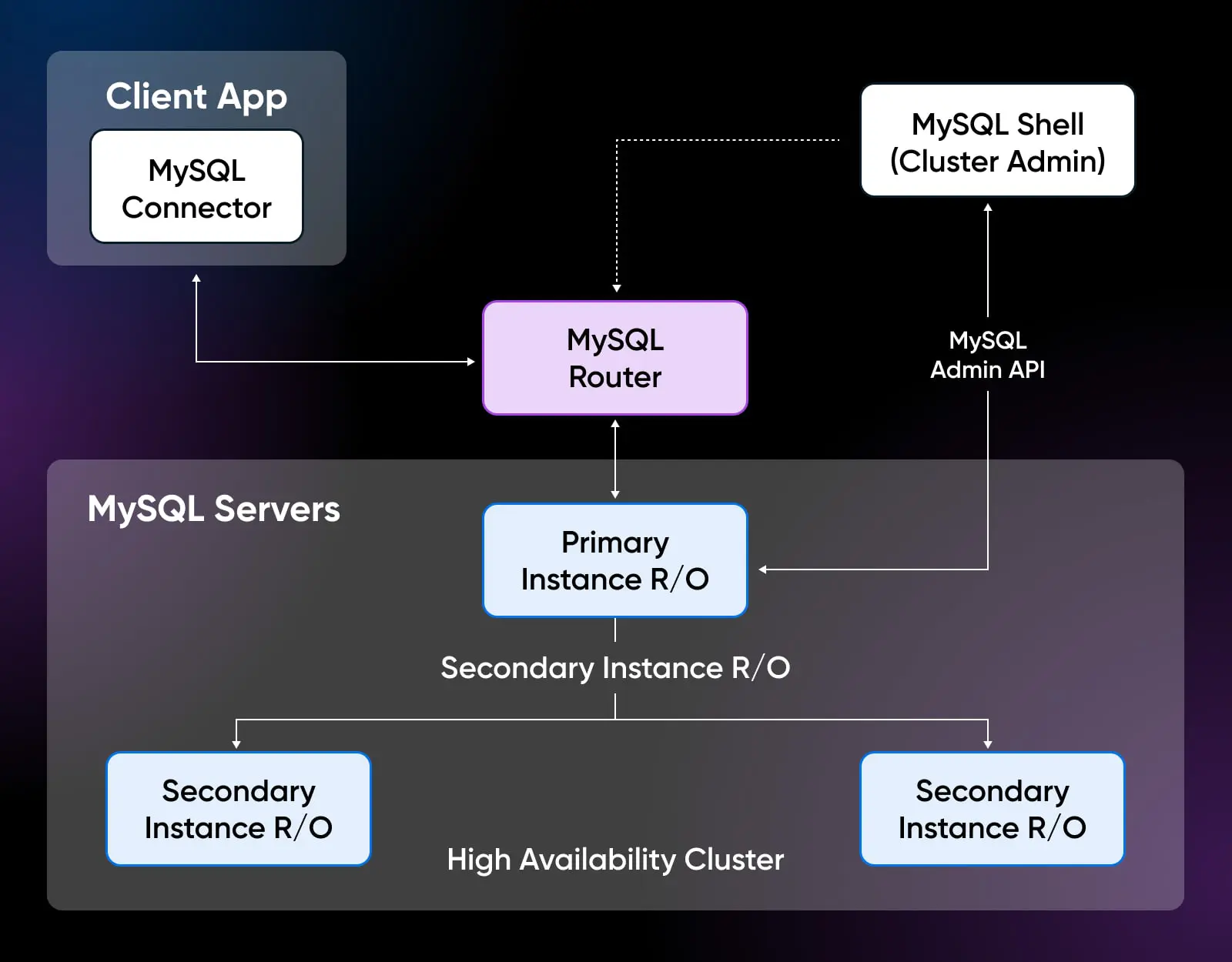
PostgreSQL also achieves high availability through replication tools like Slony, Londiste, or pgpool-II, which provide trigger-based or middleware failover. However, PostgreSQL lacks MySQL’s native clustering integration, even though you can achieve high availability.
So, if your application mandates 100% server uptime with no manual intervention, MySQL’s native clustering capabilities may serve better. That’s also one of the reasons why WordPress, a content management system that powers 43% of the internet, continues to use MySQL.
Community Support And Libraries
Given both databases’ long histories and large user bases, PostgreSQL and MySQL offer helpful forums, documentation libraries, and third-party tools. However, some differences stand out.
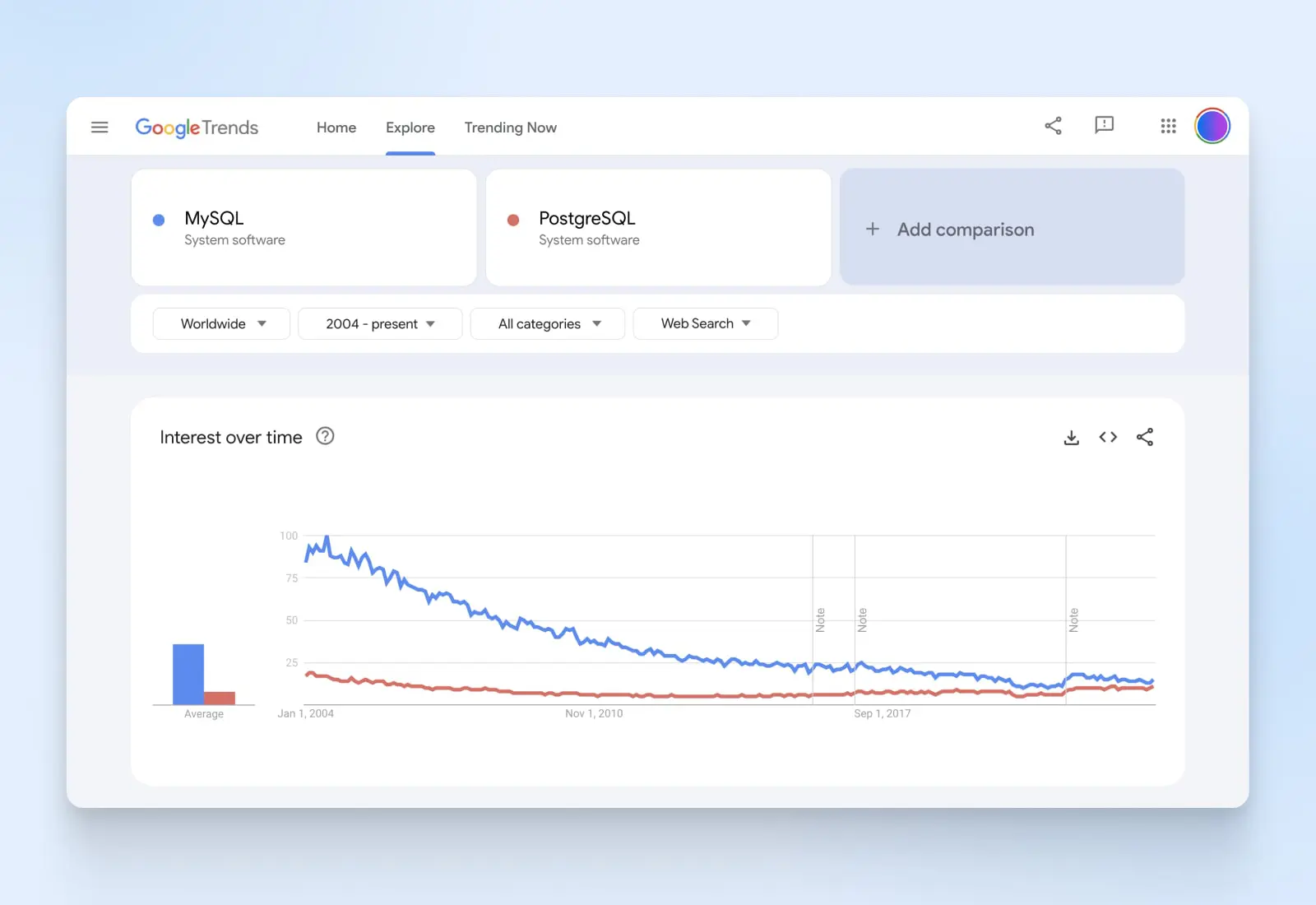
According to Google Trends, the interest in MySQL has dropped significantly, inching closer to PostgreSQL. However, both databases still have a strong following and user base, giving them good community backing.
PostgreSQL Community
PostgreSQL development is managed by the PostgreSQL Global Development Group – a team of open community developers collaborating worldwide. Thousands of users and contributors participate in the email lists, IRC channels, blogs, and events.
They also host conferences like PGConf, bringing the Postgres community together periodically. Overall, a robust, capable support ecosystem keeps PostgreSQL progressing.
MySQL Community
As a hugely popular open-source database, MySQL also enjoys online community support. The MySQL Developer Zone provides rich documentation and forums for troubleshooting issues and next steps. Large conferences like Percona Live discuss the latest best practices using MySQL.
Oracle’s acquisition of MySQL also helped it get the much-needed investment into new releases and commercial support offerings for those needing extra assistance. Though not as grassroots as PostgreSQL, MySQL users have great community resources.
Comparing Support Depth
Both databases also have excellent community support networks. PostgreSQL provides more advanced technical advice and excellent documentation, given the database’s inherent complexity. Their documentation is also a bit cheeky, unlike most other tech docs. Here’s an excerpt:
“The first century starts at 0001-01-01 00:00:00 AD, although they did not know it at the time. This definition applies to all Gregorian calendar countries. There is no century number 0, you go from -1 century to 1 century. If you disagree with this, please write your complaint to: Pope, Cathedral Saint-Peter of Roma, Vatican.”
— PostgreSQL Documentation on EXTRACT, date_part
MySQL’s community offers a broader experience perfecting beginner use cases like web applications.
But for either database, expect engaged, caring user communities ready to help guide usage and growth.
Typical Use Cases
Given the differences highlighted so far, PostgreSQL and MySQL gravitate towards some distinct use cases. However, both RDBMS systems often work perfectly fine for web applications reading and writing rows of data.
PostgreSQL Use Cases
PostgreSQL excels at very data-heavy analytic workloads such as:
- Business intelligence with complex running aggregate queries across millions of rows.
- Data warehousing and reporting across many table JOINS and conditions.
- Data science and machine learning require PostgreSQL’s array, hstore, JSON, and custom data types.
- Geospatial and multidimensional analysis via PostGIS and specialized processing. Examples include real-time location data, satellite imagery, climate data, and geometry manipulation.
These take advantage of PostgreSQL flexibility.
Specific vertical use cases abound in legal, medical, research, insurance, government, and financial verticals moving toward big data analytics.
Real-world examples include Reddit, Apple, Instagram, Johns Hopkins Hospital system genetics research, New York Times advertising analytics, Amtrak rail customer tracking, Gap employee scheduling system, Skype call detail records, etc.
MySQL Use Cases
MySQL focuses on pure speed, simplicity of development, and easy scalability inherent in web and mobile applications. Particular strengths shine for:
- High-performance online transaction processing (OLTP) for e-commerce sites and web apps needing extreme throughput on reads and writes touching numerous discrete tables per row. Think of mature sites at scales such as Airbnb, Twitter, Facebook, and Uber.
- Massively multiplayer online (MMO) games with a huge player base to support concurrently in near real-time.
- Mobile applications and the Internet of Things (IoT) require compact databases to bundle locally or embed in edge devices with occasional syncing back to data centers.
- Software-as-a-service (SaaS) multi-tenant platforms quickly scale out databases on demand while keeping data separated.
These applications prioritize availability and read/write speed at web scale over deep analytics capabilities or data science tooling. Back in 2016, Uber also moved from PostgreSQL back to MySQL, making this transition the talk of the tech community for a while.
There are many large companies that use MySQL, including WordPress, Wikipedia, Facebook, Google AdWords, Zendesk, Mint, Uber, Square, Pinterest, Github, Netflix movie browsing, YouTube video metadata, etc.
Migrating From MySQL To PostgreSQL Or Vice Versa
Given the popularity of both databases, many developers may migrate between MySQL and PostgreSQL. What should they expect during this database migration process?
Overall, migrating fully functional relational databases between MySQL and PostgreSQL works quite smoothly in most cases, thanks to the excellent migration tools available. Far more SQL syntax and functions overlap versus differ. Data types usually translate well, although doing trial conversions helps.
Let’s explore some key challenges to address:
Handling Data Type Changes
When migrating schemas from MySQL to PostgreSQL or vice versa, pay close attention to any data type mismatches:
- MySQL’s AUTO_INCREMENT columns become SERIAL in PostgreSQL.
- PostgreSQL arrays need extra syntax changes since there is no similar datatype in MySQL.
- Check date/time data conversions.
Test migrations against copies of production data to validate fidelity. Data type mismatches easily break applications if not addressed.
Stored Procedure Migration
If you rely heavily on stored procedures for business logic, migrating them between MySQL and PostgreSQL requires rewriting code.
Key differences in their procedural languages, like delimiter syntax, often break code portability. Also, confirm permissions remain intact for production procedures.
So validate your migration thoroughly and don’t assume functions come across cleanly between platforms.
Client Compatibility
Applications relying on PostgreSQL and MySQL client libraries also need reconfiguration when shifting environments:
- Update connection strings.
- Replace client library usage.
- Redirect API calls to a new platform.
Changing the underlying database necessitates application changes too. Integrate updated connectivity into your migration testing checklist.
Schema Changes From RDBMS Features
Evaluate PostgreSQL’s table inheritance, row-level security, and fine-tuned user permissions versus MySQL views and triggers to see if logic should shift to new, improved constructs available in each database. Functionality-affecting features tend to migrate cleaner, staying closer to SQL standards.
Application Code Changes
Update connection strings and drivers used, of course. Additionally, optimize the performance strengths of each database. MySQL may leverage more app-side joins and presentation logic, which is now purely in SQL on PostgreSQL. On the other hand, PostgreSQL may now implement business rule approaches that were previously only possible via MySQL triggers and stored procedures.
Fortunately, many data access frameworks like Hibernate abstract some differences away from developers by limiting exposed proprietary syntax. Evaluate if ORM or client changes make sense, too.
Proper planning, evaluations of change impact, and staging environments minimize migration stress for successfully harnessing the best each database offers.
Use Migration Tools
Fortunately, some tools help move schemas and data between MySQL and PostgreSQL with greater ease:
- pgLoader: Popular data migration utility for moving to PostgreSQL.
- AWS SCT: Database converter for homogenous migrations.
These automatically smooth over many OS/environment compatibility issues while guaranteeing identical data across systems.
So leave yourself conversion/test time, but utilize automated tools to swap databases.
What’s The Right Database For You?
Deciding between PostgreSQL and MySQL depends significantly on your specific application requirements and team skills, but a few key questions can guide your decision:
What types of data will you be storing? If you need to work with more complex and interconnected data, PostgreSQL’s flexible data types and object-relational model make that much simpler.
How mission-critical is query performance and scalability? MySQL handles throughput better for high-traffic web apps that demand faster reads. But PostgreSQL has proven stronger for mixed read-write workloads at the enterprise scale.
What administration skills does your team have? PostgreSQL rewards advanced database expertise, given its expansive configurability. MySQL is simpler for admins without excellent SQL skills to get running productively.
Platforms like DreamHost make hosting database servers easy and straightforward with VPS, dedicated servers, and cloud hosting. DreamHost handles security, and automatic backups to streamline operations so you can focus on using data for business insights.
So, let the DreamHost DBA team handle deployment and management while you architect the ideal data platform for your growth. PostgreSQL and MySQL offer open-source economics with enterprise reliability when powered by proven cloud experts. The best database for your app likely awaits – try today!


